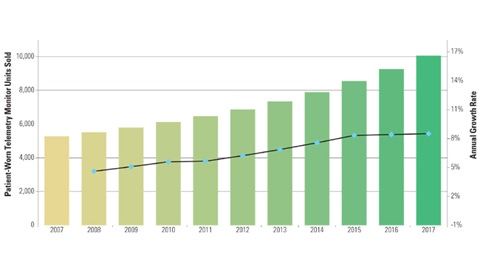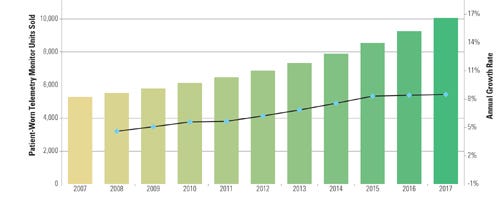Pacific Markets: Growth for Telehealth
The telehealth markets in Australia, Asia Pacific, and Japan are expected to face triumphs and challenges during the next six years.

The patient monitoring device market is comprised of equipment that is designed to measure and observe changes in vital signs, also known as the neurological, hemodynamic, and cardiac functions of a patient. The devices are used almost everywhere patient care takes place, including hospitals, alternate care sites, and at home. Overall market growth is expected as patient monitoring products become more efficient, cost-effective, convenient, and user-friendly through adoption the of wireless technology by patients and healthcare professionals alike. The Asia Pacific patient monitoring markets are strongly developed, and hospitals are aware of the benefits of monitoring. And while the overall Asia Pacific market for fetal and neonatal monitoring continues to face a number of challenges, the Australian telehealth market is expected to grow extensively through 2017. Meanwhile, the Japanese market for wireless ambulatory telemetry monitors continues to see substantial growth. Figure 1 shows the growth rate for patient-worn telemetry monitor units over the next few years in Japan.
In 2010, device maker Nihon Kohden was the leading competitor in the Asia Pacific patient monitoring device and equipment markets and held a strong presence in the telemetry, fetal, and neonatal monitoring markets. With a worldwide presence through subsidiaries and distributors, the company’s strength in the Asia Pacific market can be attributed to its advanced monitoring technology and strong reputation in Japan. Both Philips Healthcare and GE Healthcare were also significant competitors in the vital signs monitoring market and, with their extensive product lines, are expected to continue playing an influential role in the multiparameter segment.
Challenges in Fetal and Neonatal Monitoring
Although the Asia Pacific market for patient monitoring devices and equipment experienced strong growth in 2010, the market for fetal and neonatal monitoring has been shrinking due to dramatically decreasing birth rates in recent years. Fetal and neonatal monitoring are related processes that are employed at different times during pregnancy and after delivery. The procedures may be conducted invasively and noninvasively, and there are advantages and disadvantages to each method. Invasive methods for fetal monitoring are believed to be more accurate and can directly reveal genetic abnormalities in the fetus. However, the techniques can damage fetal and maternal tissues, causing trauma, and in some cases, leading to miscarriage. The advantages of noninvasive techniques are significant and range from decreased pain and tissue damage to lower costs for patients. Noninvasive methods of neonatal monitoring are thus increasing in popularity.
By 2017, birth rates in Japan and South Korea are expected to rise due to government initiatives designed to incentivize family growth. The Democratic Party of Japan intends to implement a child stipend plan that will include free education and monthly cash allowances to families with children. The South Korean government has also announced plans to offer significant tax incentives for households with two or more children. Both countries are aiming to combat the declining birth rates by encouraging families to have more children. A higher birth rate could generate a greater demand for fetal and neonatal monitoring tools beyond the 2017 forecast period. Fetal and neonatal monitor manufacturers are likely to see a higher demand for units, and the market is expected to see price erosion as new competitors enter the market.
|
Figure 1. The patient-worn telemetry monitor unit market for Japan from 2007 through 2017. |
However, despite efforts to increase birth rates, the fetal and neonatal monitoring market is still expected to decrease at a compound annual growth rate (CAGR) of -3% by 2017. The declining market can be attributed to a lack of hospital units related to obstetrics and pediatrics, particularly in Japan. The resultant surplus of devices will reduce the need for new capital equipment purchases. In addition, the average selling price (ASP) is declining due to the availability of low-cost devices from Chinese manufacturers and bulk purchase discounts, thus decreasing the overall value of the market.Other global manufacturers may be forced to lower their prices or invest in local manufacturers who can provide products at a lower cost to compete with these comparatively inexpensive solutions. However, quality is important to customers, so the strong brand reputations and value propositions offered by global manufacturers such as Philips Healthcare and GE Healthcare will help maintain prices.
Double-Digit Growth for Australian Telehealth
In 2010, the Australian telehealth market was one of the fastest growing segments within the global patient monitoring market. Telehealth refers to customized remote monitoring and the clinical management of a patient’s vital signs in the home environment. The overall goal of implementing telehealth technologies is to prevent hospital readmissions, reduce in-office visits, and better manage the health of individuals with long-term conditions.
Healthcare facilities within the hospital and alternate markets are facing reduced budgets. That pressure is driving the telehealth market, because some monitoring solutions reduce readmissions and hospital stays. Due to increased Internet access, patients are also becoming more educated and better informed of available healthcare options. Clinical evidence is widely available in Australia and many patients are beginning to request remote monitoring. Patients feel safer knowing that their health is being monitored daily rather than just during clinical visits. Australian manufacturer TeleMedCare is leading this market segment with its TeleMedCare Health Monitor, which can measure weight, temperature, blood pressure, blood glucose levels, and lung and heart function. The system also has additional options for software services. In the segment for monitoring patients with cardiac implantable electronic devices, Medtronic, Biotronik, and St. Jude Medical are the leaders.
The large geographic distance between urban centers in Australia is also driving the need for remote monitoring. Use of telehealth monitoring can reduce or eliminate the need for in-office follow up visits, thereby reducing the time and money patients spend on traveling to clinics. As a result, the Australian telehealth market is expected to grow at CAGR of almost 30% through 2017.
Japan: Wireless Ambulatory Telemetry Monitoring
Wireless ambulatory telemetry monitors are patient-worn devices that provide continuous monitoring within a particular area of coverage. They are most commonly found in cardiac care areas, such as stroke and coronary care units, where patients mobility is especially important. Despite a decrease in the ASP, the Japanese wireless ambulatory telemetry monitoring market is one of the fastest-growing segments in patient monitoring.
Through 2017, unit sales of wireless ambulatory telemetry monitors will be driven by the need to replace monitors in cardiac care areas. Newfound awareness of continuous patient monitoring will increase the demand for these devices in hospital departments that previously did not have them. Monitoring devices are also easier to operate during staff shortages. In addition to an aging Japanese population and the acknowledged benefits of patient mobility after surgery, those factors will drive the Japanese wireless ambulatory telemetry monitoring market over the next few years.
South Korean and Japanese Telehealth Markets Emerging
In 2010, the market for telehealth in South Korea was still developing. Constrained healthcare budgets and a general lack of awareness regarding the benefits of telehealth were the primary limiters of growth in this market. However, an estimated 95% of households in Korea have broadband Internet access, which could facilitate a rise in remote monitoring at home. By 2017, adoption of telehealth is expected to see substantial growth despite a strong cultural preference for face-to-face communications. In 2010, many manufacturers that participated in the global telehealth markets were not active in South Korea. However, by 2017, companies such as TeleMedCare, Care Innovations, Tunstall Healthcare, and Docobo are expected to hold significant market share.
The Japanese market for telehealth remains undeveloped, but it has seen rapid adoption and interest in healthcare-related products such as telehomecare devices, alarm monitoring systems, and video conferencing. Many of these devices are developed by Japanese household electric appliance manufacturers. It is estimated that 90,000 people in Japan were using telecare alarm systems in 2010. Some telehealth homecase devices are considered medical-grade products and are eligible for funding by Japanese healthcare providers.
Conclusion
The combined patient monitoring markets in Asia Pacific are expected to exceed $652 million by 2017. This growth will be driven primarily by the increased demand created by the aging and growing populations in Japan, South Korea, and Australia. Patient monitoring devices play a role in nearly every patient hospital visit and will continue to be essential as healthcare services develop and expand. Manufacturers in this market must continue to offer products with greater wireless capabilities and user-friendly features to capture market share.
Kamran Zamanian, PhD, is president and CEO of iData Research Inc. (Vancouver, Canada). Sara Whitmore is a lead analyst at the firm.
The information contained in this article is taken from a detailed and comprehensive report published by iData Research entitled “Asia Pacific Markets for Patient Monitoring Devices 2011.
About the Author(s)
You May Also Like

.png?width=300&auto=webp&quality=80&disable=upscale)
